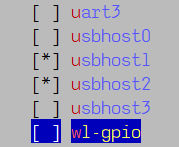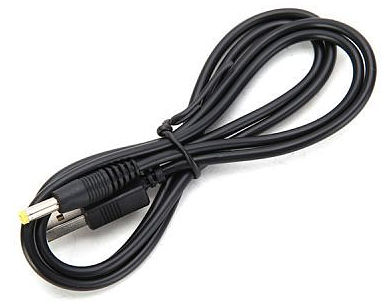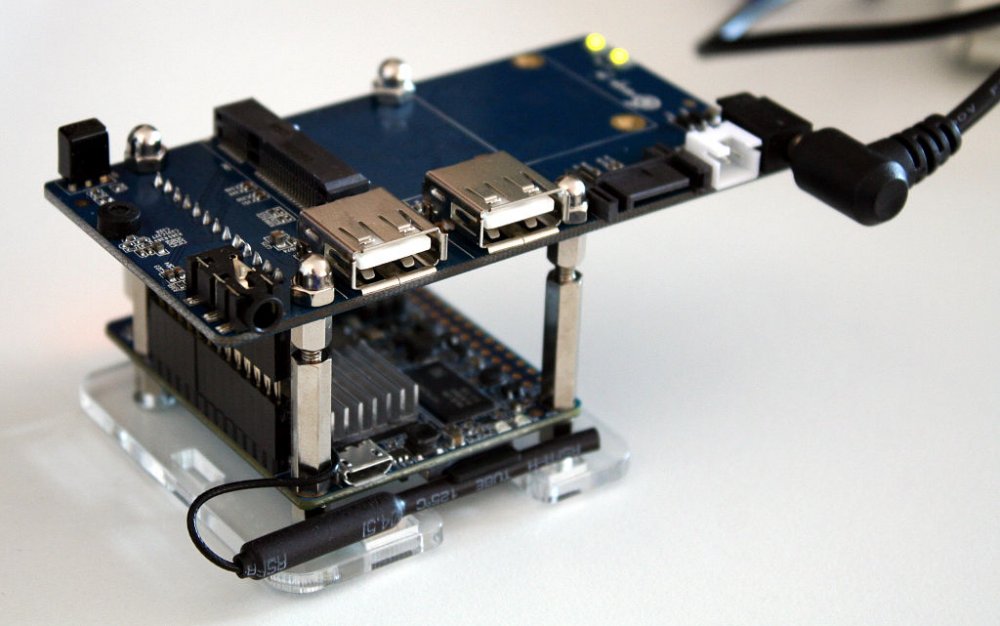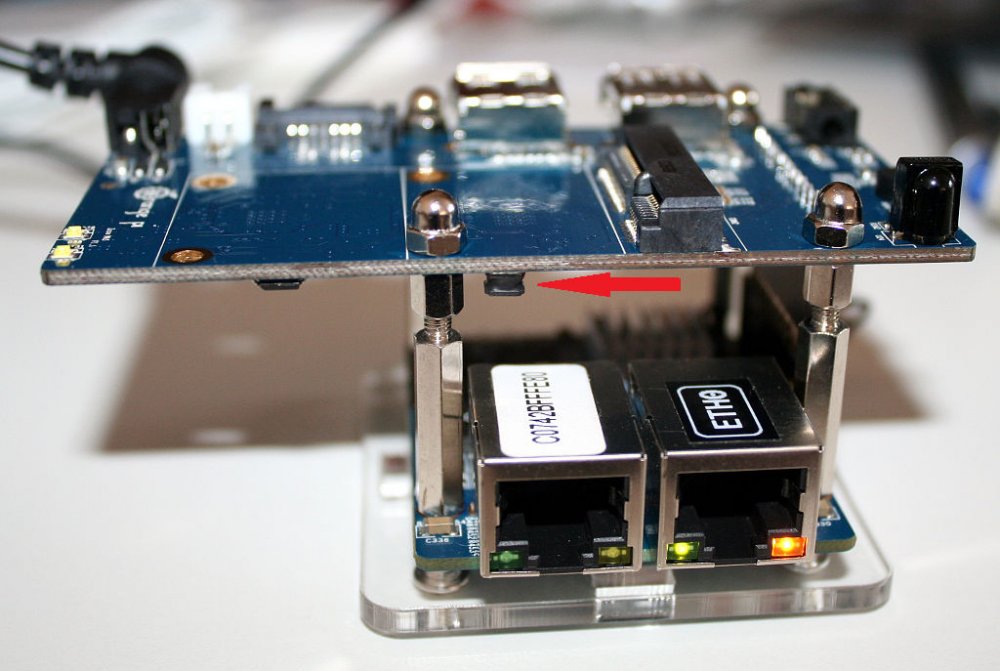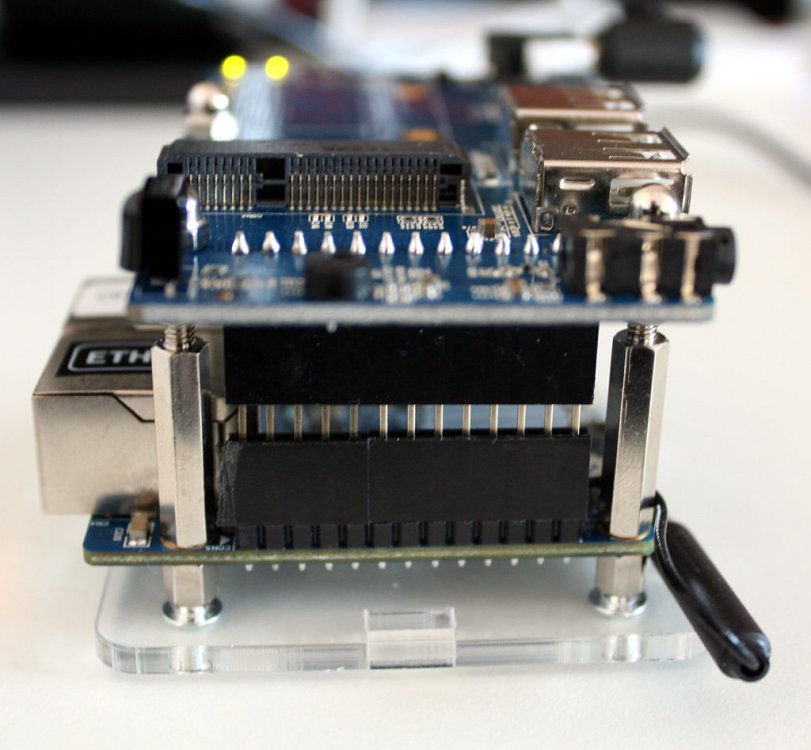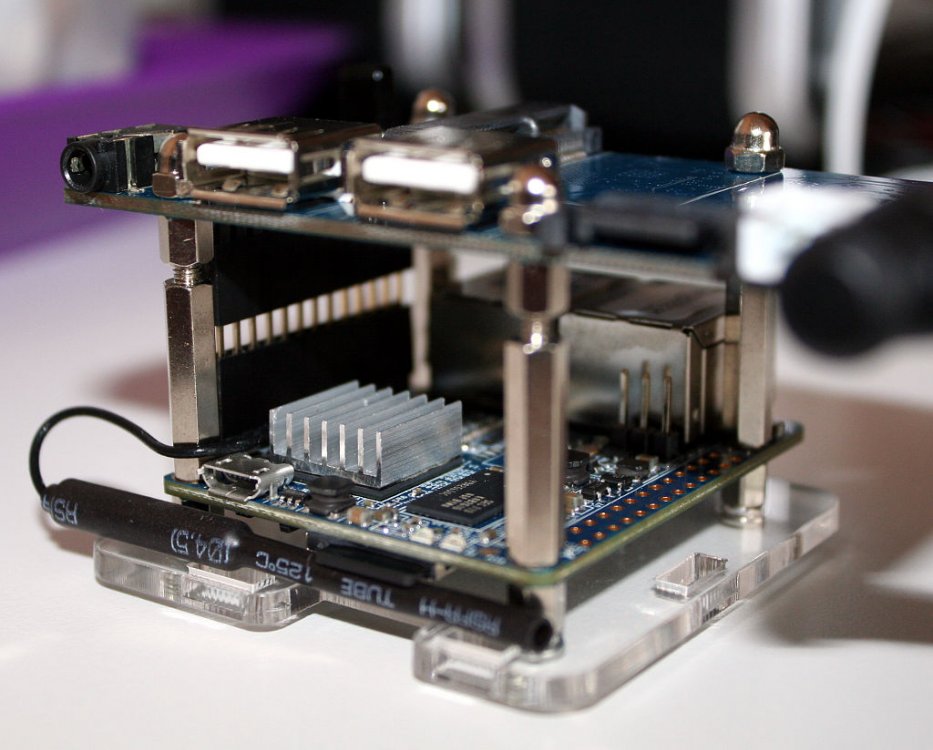-
Posts
1791 -
Joined
-
Last visited
Content Type
Forums
Store
Crowdfunding
Applications
Events
Raffles
Community Map
Everything posted by guidol
-
and of which type/manufacturer/size was the bad card?
-
Today I installed Armbian_5.35_Odroidc2_Debian_jessie_default_3.14.79 on my Odroid C2 Installation went fine and I got a DHCP-IP But now neither armbian-config will configure me a IP to eth0 (only device lo) nor /etc/network/interfaces would be "read" when I manually edit it to eth0 So I cleared the file. nmtui does let me configure a connection and I could activate this connection. At this time I got a/the right IP. But after a reboot this IP wouldnt reconnected. Every boot I do get an additional connection eth0 generated. Before boot root@odroidc2:~# nmcli con show NAME UUID TYPE DEVICE guido 2b96719d-bbee-4fef-9848-8663cda99dcc 802-3-ethernet eth0 eth0 3888b480-d230-4bf7-a3b3-076f4b61b35b 802-3-ethernet -- After next boot root@odroidc2:~# nmcli con show NAME UUID TYPE DEVICE eth0 569592fe-7704-4054-bb6a-74567526cd72 802-3-ethernet -- guido 2b96719d-bbee-4fef-9848-8663cda99dcc 802-3-ethernet eth0 eth0 3888b480-d230-4bf7-a3b3-076f4b61b35b 802-3-ethernet -- So I named "my" connection guido and did try the following in the /etc/rc.local nmcli con down eth0 nmcli con up guido but on startup the boot-log (not in dmesg) shows me: [FAILED] Failed to start /etc/rc.local Compatibility. [EDIT] as workaround it does work with these 2 nmcli config-lines if I put a "sleep 1" before them in the /etc/rc.local but this shouldnt be the final solution But manually these command does work: Connection successfully activated (D-Bus active path: /org/freedesktop/NetworkManager/ActiveConnection2) root@odroidc2:~# armbianmonitor -u System diagnosis information will now be uploaded to http://sprunge.us/ADIU
-
Is there a command to switch the boot priority back to uSD in armbian? Doesnt seem to be possible: So I neet a eMMC to uSD adapter Doenst see that kind of adapter alone at eBay The eMMCs at FriendlyElec got another Connector and is Out of Stock. I do need a version like from hardkernel (or the sellers of the Pinebook) (Hardkernel wants $16 postage for this $1.50-Item )
-
also a updated Armbian_5.33.171013_Odroidc2_Debian_stretch_next_4.13.5.7z doesnt boot anymore I did update the version above on my eMMC and now the C2 wont boot anymore from eMMC. But I dont understand - he wont boot anymore when the updated eMMC is connected AND a uSD with a older (13.10.2017) version is inserted. Shouldnt the uSD have priority before the eMMC? - and I didnt got a uSD adapter fo the eMMC because it was out of my Pinebook. So I cant fresh format the eMMC Now I'll take the v5.35 with legacy kernel on uSD....
-
the IP from the Internet provider hasnt to be static Your Orange Pi seems to get his IP via DHCP from the router/DSL-Modem, but is missing the DNS-Server entry, because you can ping to the internet (8.8.8.8) but the Orange Pi doesnt know the name of the Google-IP. Normally the router/DSL-Modem also submit the IP of the DNS-Server via DHCP to your computer/Orange PI. Do you have other computers working via DHCP while connected to your router/DSL-Modem? For a first test you could try to add a DNS-Server to your connection. First try to find the name of your connection with : nmcli con show -a then add dns-servers to the connection: nmcli con mod [the_name_of_your_connection] ipv4.dns “8.8.8.8 8.8.4.4” https://www.tecmint.com/configure-network-connections-using-nmcli-tool-in-linux/
-
I got also problem with the GUI-Network-connection in Pixel Desktop on Raspberry. Please try to use nmtui-connect or nmtui in the Shell/Console Check if you got the right /etc/network/interfaces which is managed by the network-manager: https://docs.armbian.com/User-Guide_Fine-Tuning/#how-to-change-network-configuration
-
Yes - because I had before the R1 on 4.x Kernel I reinstalled another uSD with 3.4.x legacy kernel: OPi Zero R1: ------------ ARMBIAN 5.35 user-built Ubuntu 16.04.3 LTS 3.4.113-sun8i Linux opi-zero-r1 3.4.113-sun8i #4 SMP PREEMPT Wed Nov 22 13:45:28 CET 2017 armv7l armv7l armv7l GNU/Linux OPi Zero (normal-version): -------------------------- ARMBIAN 5.35 user-built Ubuntu 16.04.3 LTS 3.4.113-sun8i Linux orangepizero 3.4.113-sun8i #4 SMP PREEMPT Wed Nov 22 13:45:28 CET 2017 armv7l armv7l armv7l GNU/Linux
-
Today I reinstalled my OPi R1 with stable/legacy for testing IR/lirc with the IR-Port of the NAS-Expansionboard. I installed the IR-Support via armbian-config (network-section) and it automatically loads the module sunxi_cir Modules are loaded and I get a /dev/input/event2 - but evtest /dev/input/event2 did only produce this output and doesnt recognize the IR-remote: root@opi-zero-r1:~# evtest /dev/input/event2 Input driver version is 1.0.1 Input device ID: bus 0x19 vendor 0x1 product 0x1 version 0x100 Input device name: "sunxi-ir" Supported events: Event type 0 (EV_SYN) Event type 1 (EV_KEY) Event code 152 (KEY_SCREENLOCK) Event type 4 (EV_MSC) Event code 4 (MSC_SCAN) Key repeat handling: Repeat type 20 (EV_REP) Repeat code 0 (REP_DELAY) Value 500 Repeat code 1 (REP_PERIOD) Value 125 Properties: Testing ... (interrupt to exit) My OrangePi Zero does load all modules if I modprobe sunxi_cir and does respond to the IR-remote: root@orangepizero:/etc/lirc# evtest /dev/input/event2 Input driver version is 1.0.1 Input device ID: bus 0x19 vendor 0x1 product 0x1 version 0x100 Input device name: "sunxi-ir" Supported events: Event type 0 (EV_SYN) Event type 1 (EV_KEY) Event code 152 (KEY_SCREENLOCK) Event type 4 (EV_MSC) Event code 4 (MSC_SCAN) Key repeat handling: Repeat type 20 (EV_REP) Repeat code 0 (REP_DELAY) Value 500 Repeat code 1 (REP_PERIOD) Value 125 Properties: Testing ... (interrupt to exit) Event: time 1511898396.197217, type 4 (EV_MSC), code 4 (MSC_SCAN), value 116 Event: time 1511898396.197227, -------------- SYN_REPORT ------------ Event: time 1511898397.768212, type 4 (EV_MSC), code 4 (MSC_SCAN), value 11a Event: time 1511898397.768236, -------------- SYN_REPORT ------------ I did take a look at the fex-edit in armbian-config for the 2 boards and the section for IR seems to be the same. Can I take a look in anything other? on the OPi Zero R1 the follwing lirc-components are installed: root@opi-zero-r1:~# dpkg -l|grep lirc ii inputlirc 23-2 armhf Zeroconf LIRC daemon using input event devices ii liblircclient0:armhf 0.9.0-0ubuntu6 armhf infra-red remote control support - client library ii lirc 0.9.0-0ubuntu6 armhf infra-red remote control support ii lirc-x 0.9.0-0ubuntu6 armhf infra-red remote control support - X utilities and on the normal OPi Zero this lirc-components are installed: root@orangepizero:/etc/lirc# dpkg -l|grep lirc ii inputlirc 23-2 armhf Zeroconf LIRC daemon using input event devices ii liblircclient0:armhf 0.9.0-0ubuntu6 armhf infra-red remote control support - client library ii lirc 0.9.0-0ubuntu6 armhf infra-red remote control support ii lirc-x 0.9.0-0ubuntu6 armhf infra-red remote control support - X utilities seems to be the same
-
I did take a look for an overview ( http://orangepi.com.tr/destek.html ) and all I could see was fine They also added the R1 which before wasnt there
-
Hmm...cable seems to be thick enough and also the power should deliver enough Ampere - but it sounds for me more as a powersupply problem than a OPi problem. Could you connect the powercable to a USB-Connector and run from another powersupply? The OPi doenst need much Ampere - my OPi One is running from a normal USB-Port (from Synology NAS) as Pi-Hole You could try to meassure the Ampere while the OPi is connected. Maybe the powersupply Ampere or Volt when connected.
-

NanoPi Neo2 and Neo Station NS-120B with armbian
guidol replied to guidol's topic in Allwinner sunxi
at the time I started with armbian on the NanoPi NAS USBHost3 was loaded automatically. So I activated Overlay 1&2. Not the USBHost0, because I doenst gave me additionally USB-Ports -

NanoPi Neo2 and Neo Station NS-120B with armbian
guidol replied to guidol's topic in Allwinner sunxi
This is activated by the armbian version in the beginning of Nov 2017. At this time the Overlay usbhost1 has been activated - this would activate this USB Port. see the following thread: -
Do you got another power cable? I did buy cables for the power-socket which has USB on the other end and my 2 OPi One do work also on normal USB Port of my NAS or computer: https://www.robotistan.com/orange-pi-plus-2-guc-kablosu I dont think that booth could be defective - one maybe but two - I dont think so. How about some pictures of your cable, Power adapter, Case? You do power viathe power-socket and not via micro-usb? Whats the TTL-Output with non armbian images?
-
mine has one line more - on many different Pi-computers - doesnt know if this line does the magic: pcm.!default { type hw card 1 device 0 } ctl.!default { type hw card 1 } because card 1: sndhdmi [sndhdmi], device 0: SUNXI-HDMIAUDIO sndhdmi-0 []
-
because I got the same "problem" with my Orange Pi R1 and the audio from the NAS-Expansionboard I did use a little workaround First I do "send" a empty .wav to the audio-System, then sleep a second and then do the normal output - when the soundsystem is awake root@opi-zero-r1:/home/guido# more ./speak.sh espeak -w /tmp/espeak.wav -s150 ""; aplay -D plughw:0,0 /tmp/espeak.wav 2>/dev/null sleep 1 espeak -w /tmp/espeak.wav -s150 "$1"; aplay -D plughw:0,0 /tmp/espeak.wav 2>/dev/null Linux opi-zero-r1 4.13.14-sunxi #240 SMP Mon Nov 20 00:09:06 CET 2017 armv7l GNU/Linux
-
I did wrote them a mesage - in english, because I cant it in turkish - and hope they could understand it
-
Here in turkey they got a own webpage for/from Orange Pi: http://orangepi.com.tr/index.html On their download-pages for the Orange Pis they have mostly armbian-images linked. OK, old 5.25 ones - but they refer for other Operating Systems the normal Orange Pi webpage. Download Page is http://orangepi.com.tr/destek.html , but you have to select the model of the OPi. Orange Pi Türkiye Armbian İşletim Sistemi'ni önerir. Orange Pi Turkey Suggests the Armbian Operating System. The NAS-Expansion for my OPi Zero/R1 did I get from the distributor here in Turkey (Türkiye): https://www.robotistan.com/orange-pi For me the new best way to buy OPis here (1-2 day delivery against more than a month from china)
-
Something that you normally "like": the R1 isnt a device anymore that is MicroUSB-powered. Now he get his 5V via the 13 Pin Header from the external 5V/3A Power-Supply of the Expansion-Board
-
Audio enabled and Internetradio does also work armbian-config: Toogle hardware config Choose what you want to enable or disable [*] analog-codec root@opi-zero-r1:~# aplay -l **** List of PLAYBACK Hardware Devices **** card 0: Codec [H3 Audio Codec], device 0: CDC PCM Codec-0 [] Subdevices: 0/1 Subdevice #0: subdevice #0 root@opi-zero-r1:~# lsmod Module Size Used by sun4i_codec 32768 3 sun8i_codec_analog 24576 1 snd_soc_core 118784 2 sun4i_codec,sun8i_codec_analog snd_pcm_dmaengine 16384 1 snd_soc_core snd_pcm 69632 3 snd_pcm_dmaengine,snd_soc_core sun4i_gpadc_iio 16384 0 snd_timer 24576 1 snd_pcm snd 45056 4 snd_timer,snd_soc_core,snd_pcm soundcore 16384 1 snd
-
But the R1 has the same form-factor for the mounting holes and the 13 pin connector is also the same at the same place I personally dont like OpenQRT - so I would like more to have a Boot-Loader in the SPI which enables the R1 to boot from USB. The Orange Pi Zero Plus ( not the -2- only the Zero Plus H5) is ordered, but will came in the end of 2017 or January 2018 but will also be placed in a small hot black Cube As NAS I got my 2 NanoPi Neo2 (and the Synology and a Realtime-OS IcyBox-NAS). The R1 has did get the NAS-Board for the USB and SATA Ports because he didnt got a case - so its a open working system Its for Fun and testing - and because it was directly buyable her in turkey
-
I dont know how good the R1 is set up for the small Non-NAS-Expansionboard (2x USB, Audio/Composite Video), BUT the NAS-Board doenst seem to be made with the R1 in Mind. I ordered the NAS-Board for the Zero for using ist wit the R1. But it came without the metall spacer and screws Just putting it together without the spacers did show that a electric component will collide with one of the ethernet ports (see the red arrow in the picture) So I had to get some distance between the Orange Pi Zero R1 and the NAS-Expansionboard.. Lucky me - I had some spare parts from 2 Acrylic OPi Zero cases laying around with some higher spacers and matching screws. To get more distance I used connector-extensions from/for an Arduino. Normally the Arduino has 8 pins + 6 pins - but I had to cut the 6 pin extension so fit the 5 pin width and I had to shorten the pins of the Arduino-Extensions to fit the hight of the spacers from the Acrylic case. For the bottom I also did use one of the Acrylic plates as foot-stand So this may be the first (and may be at this time the only) Orange Pi R1 with the NAS-Expansionboard "on the world" With the armbian-image I used before the USB-Ports on the Expansionboard do work (didnt checked by now the other ports): Linux opi-zero-r1 4.13.14-sunxi #12 SMP Sun Nov 19 10:35:41 CET 2017 armv7l GNU/Linux root@opi-zero-r1:~# lsusb Bus 008 Device 001: ID 1d6b:0001 Linux Foundation 1.1 root hub Bus 005 Device 002: ID 058f:9380 Alcor Micro Corp. Flash Drive Bus 005 Device 001: ID 1d6b:0002 Linux Foundation 2.0 root hub Bus 007 Device 001: ID 1d6b:0001 Linux Foundation 1.1 root hub Bus 004 Device 002: ID 03f0:5307 Hewlett-Packard v165w Stick Bus 004 Device 001: ID 1d6b:0002 Linux Foundation 2.0 root hub Bus 006 Device 001: ID 1d6b:0001 Linux Foundation 1.1 root hub Bus 003 Device 002: ID 0bda:8152 Realtek Semiconductor Corp. Bus 003 Device 001: ID 1d6b:0002 Linux Foundation 2.0 root hub Bus 002 Device 001: ID 1d6b:0001 Linux Foundation 1.1 root hub Bus 001 Device 001: ID 1d6b:0002 Linux Foundation 2.0 root hub
-

NanoPi Neo2 and Neo Station NS-120B with armbian
guidol replied to guidol's topic in Allwinner sunxi
Is it normal that the OMV image uses BTRFS as root?: Now trying to resize btrfs filesystem on /dev/mmcblk0p2 to the limits: Resize '/' of 'max' [ 0.000000] Kernel command line: root=UUID=c87187d0-ce6f-4286-b012-8aee5328e3a8 rootwait rootfstype=btrfs console=tty1 console=ttyS0,115200 panic=10 consoleblank=0 loglevel=1 ubootpart=b13f7316-01 usb-storage.quirks= cgroup_enable=memory swapaccount=1 and why is /dev/sda3 BTRFS?: [ 3.414485] BTRFS: device fsid c87187d0-ce6f-4286-b012-8aee5328e3a8 devid 1 transid 9 /dev/mmcblk0p2 [ 3.415791] BTRFS: device fsid 8f658c3f-c8a8-489b-b52e-bb9e7bc87f24 devid 1 transid 31 /dev/sda3 -
a starting point for a H3 Board with Wifi and Bluetooth and eMMC is the NanoPi Neo Air: http://www.friendlyarm.com/index.php?route=product/product&product_id=151 but without a HDMI-Port it is more for "server"/headless apps And you should get their heat-sink and the additional antenna
-
If you want to update the KODI under Sunvell Android - there is the problem that their Android 6.0.1 is a fake. Its only a 4.4 Kitkat which shows a Android version number of 6.0.1 And for Android 4.4 is no new KODI available - but you could get a patched version of Kodi 17.1 (EBOX-Logo) : https://www.entertainmentbox.com/install-kodi-17-krypton-android-4-4-solved/ https://quickfileshare.org/te/EBMC_17.1_4.4.apk or https://play.google.com/store/apps/details?id=com.appmakr.entertainmentboxretrogameing


